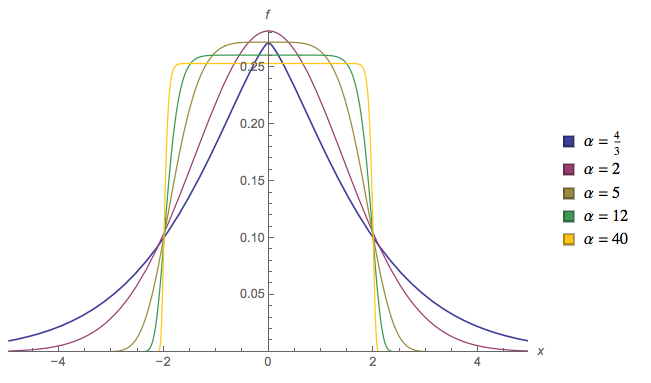While Nadarajah (2005) may have used the term 'generalised Normal' to describe a density that nests this form, there are more suitable names that extend far further back in time, and which accordingly seem much more appropriate.
In particular, I believe this should properly be referred to as a Subbotin distribution (Subbotin 1923). Other later references include:
Diananda (1949)
Turner (1960)
Zeckhauser and Thompson (1970)
McDonald and Newey (1988)
Mineo and Ruggieri (2005)
The functional form given by Subbotin (1923) defines the pdf as:
$$f(x) = \frac{\alpha }{2 b \Gamma \left(\frac{1}{\alpha }\right)}\text{exp}\left[-\left|\frac{x}{b}\right|^{\alpha }\right]$$
Subbotin used parameter $b = 1/h$, but the functional form is otherwise identical to that given here. In this form: $$Var(X) = \frac{b^2 \Gamma \left(\frac{3}{\alpha}\right)}{\Gamma \left(\frac{1}{\alpha}\right)}$$
Here is a plot of the pdf with $b=2$, as parameter $\alpha>1$ varies:
 (source)
(source)
and again for parameter $0<\alpha<1$:
 (source)
(source)
Other names include: Box-Tiao distribution (McDonald and Newey 1988), and Power-Exponential (McDonald and Newey 1988, Johnson et al. 1995). Finally, it is worth noting that some economic papers inappropriately ascribe the name 'Subbotin distribution' to an Exponential-Power distribution that has a different functional form.
References
Subbotin, M.T. (1923), On the law of frequency of error, Matematicheskii Sbornik, 31, 296-301.
Diananda, P. H. (1949), Note on some properties of maximum likelihood estimates, Proceedings of the Cambridge Philosophical Society, 45, 536-544.
Turner, M. E. (1960), On heuristic estimation methods, Biometrics, 16(2), 299-301.
Zeckhauser, R. and Thompson, M. (1970), Linear regression with non-normal error terms, The Review of Economics and Statistics, 52, 280-286.
McDonald, J. B. and Newey, W. K. (1988), Partially adaptive estimation of regression models via the generalized t distribution, Econometric Theory, 4, 428-457.
Mineo, A. M. and Ruggieri, M. (2005), A software tool for the Exponential Power distribution: the normalp package, Journal of Statistical Software, 12(4), 1-21.


